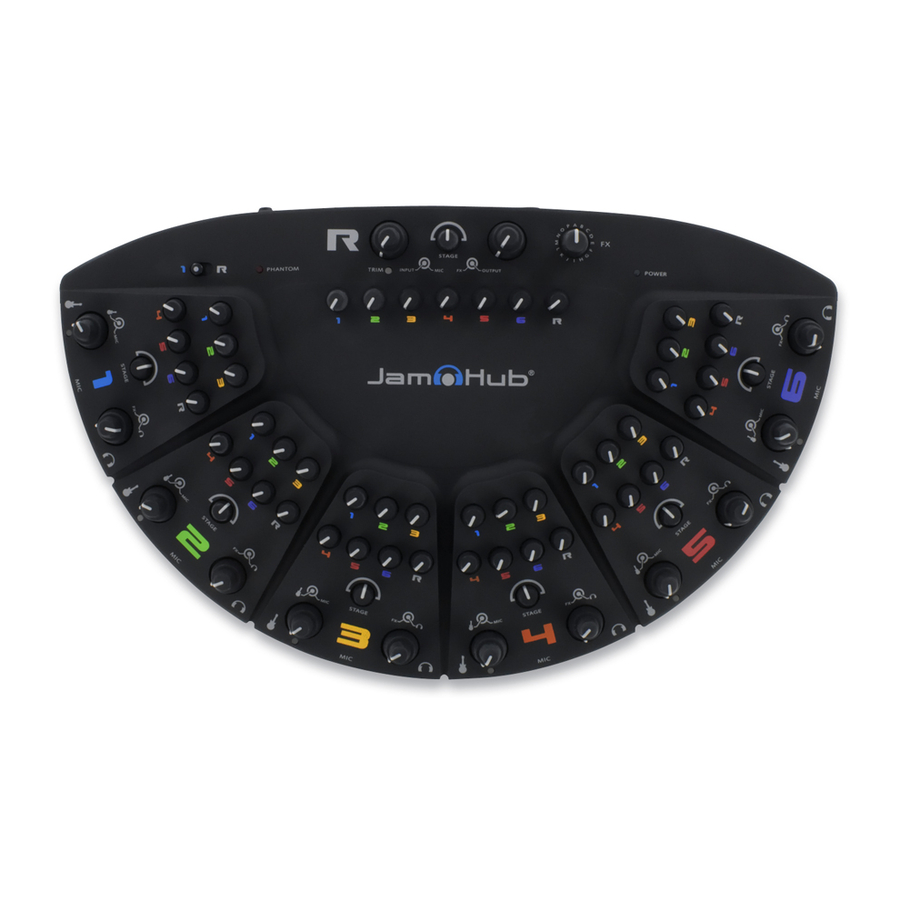JamHub TourBus Instrukcja obsługi - Strona 7
Przeglądaj online lub pobierz pdf Instrukcja obsługi dla Mikser muzyczny JamHub TourBus. JamHub TourBus 12 stron.
Również dla JamHub TourBus: Instrukcja obsługi (12 strony)

The SoleMix controls
The SoleMix
TM
controls found on each JamHub section
and on the SoleMix remote are easy to understand
and use once you know the basic layout and design of
a JamHub system.
First, look at your JamHub from the top. You'll see
that there are 4 or 6 numbered sections that are also
color-coded. (the "R" section is reviewed below)
Typically you'll want to use one section per musician.
If you are the guitar player, you connect your mic and
amp modeling device into section 1. Now everyone
in the band can use their SoleMix controls to balance
section 1's level in their headphones by simply turning
up or down the control marked "1" on their SoleMix
section. The same applies to the "2", "3" and "4" con-
trols in each section.
Don't forget about the effects return knob. This allows
you to decide how much of the effects engine you
want to hear. The "dry" signal comes through each
person's numbered SoleMix controls and the "wet"
signal comes through the "FX" control (under the headphone volume).
What's cool about a JamHub is that once you know one section of the product, you know all the sections of the product.
Pretty easy, huh?
What's up with the "R" section?
"R" section layout
Here's a little secret. The R section (for "rear" or "recording") functions exactly the same as all the other SoleMix sections.
While it may look a little different, take a closer look. You'll see that all the knobs are the same. The only difference is
how they are laid out on the JamHub.
Want to jam along with a recording of a song? Plug your MP3 player into the R section. Then each musician can decide
how much of the song to hear by turning up (or down) the R knob in their SoleMix section.
The R section is also designed for recording your jams. Just like one musician's mix is different from another's, a record-
ing mix is unique and you'll want to use this section to make the right mix for recording. Can you use the "R" section for
another musician? Sure! Remember, it is simply another section of the JamHub.
To record, create a recording mix with the "R" section controls and connect to a computer or a portable recorder to the R
section and create a rehearsal recording. Make sure whoever you want in charge of the recorded mix is also plugged into
section 1. Read on to find out why.
12
SoleMix section layout
1
The
- R switch for auditing your recording mix
The 1 - R switch is for listening to the mixes coming from section 1 and the
R section. If you're the person responsible for the recording mix, you'll
need to hear both the R mix as well as your own mix on section 1. So we
designed the JamHub
with a handy little switch that allows you to quickly
®
flip back and forth between these two sections.
Left Brain:
This switch takes the output of the R section and redi-
rects it to section 1 headphone jack. When the switch
is in the 1 position, the SoleMix
output for section 1
TM
is sent to the headphone jack of section 1. When the
switch is in the R position, the SoleMix output set in the
R section is sent to both the R section headphone jack
and the headphone jack in section 1.
Effects engine and settings
The effects engine in your JamHub silent rehearsal studio allows you to
create a "room" inside the unit and decide how much of it you want to hear.
Or, you can try one of the pure effects like flanger or phaser for something a
little different.
Each section, and each remote, can set how much of the effects engine
they would like in their mix. It allows each player can decide how much they
want to "wet out" the vocals.
The effects engine is connected to the mic inputs only. We did this because
most modeling amps, keyboards and electronic drums have their own built-
in effects. If you've ever heard one reverb put on top of another reverb, you
understand why we avoided mixing the two.
Left Brain:
The stereo effects engine is coupled to a set of 24-bit
48kHz audio codecs to ensure great sound quality. The
effects engine has 16 preset algorithms which cover all
of your basic needs and a few unusual effects thrown
in for fun. The codecs are wide bandwidth (100dB) and
low noise (s/n of 105dB).
Right Brain:
If you're in charge of the recording mix, you need to
hear your mix for playing and the mix for recording.
To do this, you can disconnect your headphones from
your section's headphone jack and plug them into the
R section's headphone jack to hear the recording mix.
Or, make section 1 your mix, leave your headphones
plugged into section 1, and use the 1-R switch to quick-
ly alternate between your mix and the recording mix.
Right Brain:
The types of effects cover a variety of options and each
musician can use the FX knob to control how much, or
how little, of the effects they want to hear.
13
